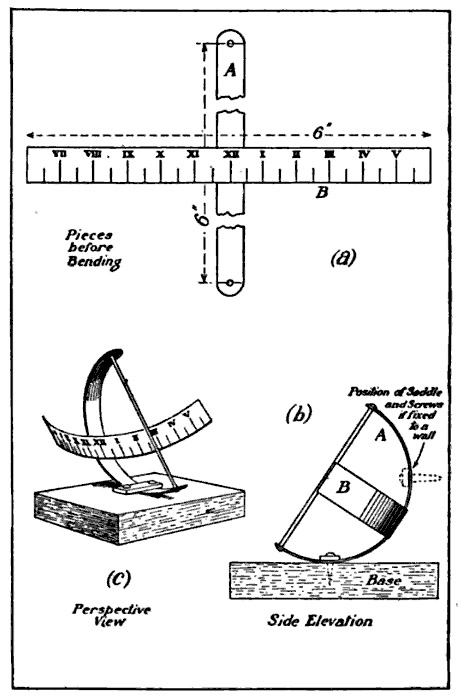A HOME-MADE SUNDIAL
A sundial is an interesting thing to have on a garden wall or the stump of a tree, or to set in a south-facing window. Ordinary flat and vertical sundials require the use of advanced mathematics; but that to be described is within the capacity of any handy person.
One begins by making a cross of thin metal. Brass, copper, zinc are all suitable; copper is the best. The cross may either be cut in one piece out of the sheet, or be compounded of a vertical piece and a cross piece riveted together at the point of crossing. The dimensions given in Fig. 44, a, are for a small dial, but they may be modified to suit individual fancy, provided that the circumferential length of the cross-piece B be the same as the distance between the centres of the holes in A. Mark off the cross-piece into twelve equal parts, and subdivide each of these into quarters or twelfths. The lines may be scratched or etched with acid. For the hours use the Roman numerals, which, being made up of straight lines, are very easily engraved.

When this has been done, bend both pieces to a truly semicircular shape. To get the curve correct one must cut out a cardboard circle with half its circumference equal to the length of the crosspiece piece and use it as a template. The exact diameter can best be arrived at experimentally. If copper or brass be used, anneal it by red-heating and plunging into cold water before it is bent.
As the pieces are easily distorted, if of thin metal, it is advisable to solder to the back of each a rib of the same metal, cut out with the aid of the template already made. One rib will have to be severed at the crossing-point to give room to the other rib, to which it should be soldered. If stout strip metal be used, this backing will be unnecessary, but in this case a wooden template had better be cut to the right curve to enable the shaping to be done accurately by hammering. After shaping, slip a piece of quite straight copper wire through the holes in A, and make them fast with solder.
The dial is now fixed facing the south (in our northern
latitudes), with the wire sloping towards the north, and making with the
horizontal an angle approximately equal to the latitude of the place --for
The dial is most easily fixed by means of a little wooden
saddle crossing A, with a screw at each end penetrating either a horizontal
base board (as shown) or the face of a wall -- in which case the saddle would
occupy the position indicated by the dotted lines.
When consulting the dial at any time, add or subtract the

Leave a comment